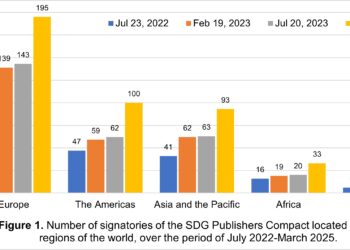
Reflect on the past century of revenue sources for scholarly publications, and you might see a pendulum swinging between individuals and institutions, with the rate of traversal increasing recently as technology and economics all add pressure to various parts of the system.
Prior to World War II, scientific publications amounted to luxury items, provided either via libraries, by mail via a membership society, or shared informally. Print was the only option, and having information bound to physical forms limited distribution, making the economics of individual subscription inevitable and structurally protected.
After World War II, with more scientists and physicians trained and new-found prosperity, first in the US and UK, then elsewhere, personal subscriptions to favored publications became more common. As lists of recipients lengthened, the “Mad Men” era of advertising took note. The resulting advertising subsidies allowed for cheaper subscriptions in many fields, which further accelerated the trend toward personal subscriptions. The goal became reaching individual subscribers, especially as other forms of advertising (jobs, in particular) joined the party.
Until the late-1990s, these trends — affordable personal subscriptions, heavily subsidized by advertising revenues — dominated many journal business models. The industry became so accustomed to the benefits of this approach — costs that are widely dispersed so that each person pays relatively little, subsidized costs due to advertising and other secondary revenue sources (e.g., page and image charges) — that some assumed these assumptions would carry over to any information business model.
Then, relatively quickly, the pendulum swung away from print and its inherent business model assumptions (scarcity, personal delivery, valuable but hard-to-measure advertising, time-tested subsidies). The countervailing force was electronic delivery, which had other assumptions built into it — shared infrastructure, abundance, impersonal delivery, and measurable advertising. Most of these have not turned out to be the financial panaceas once imagined — managing the shared infrastructure is costly, measurable advertising is less lucrative — but the personal subscription for information was relegated to a secondary role, if not dismissed altogether. The swing from personal subscriptions to group subscriptions gained momentum.
This framework provides some hints that the pendulum may still be swinging. While we generally think of the article processing charge (APC) as a way of having authors pay, it also can be viewed as a way for individuals to pay — or, if a grant or other funding source is involved, as a mix of personal and institutional sources of revenues. Either way, the pendulum is not at rest, and individuals as payers still exert a pull on its trajectory and speed. Submission fees are either being implemented or contemplated, another source of individual revenues. Page and color charges are still with us here and there, or are morphing into other author charges (e.g., for data or longer versions). And charges for continuing education provide another source of revenue from individuals.
These are not the only trends tugging at the pendulum. Sci-Hub has raised the issue of individual accountability for subscription access, both at the institutional and the personal level. The scales have fallen from our eyes as far as accountability for contracts and security among the individuals running and working in libraries, while the messier issues around personal utilization of Sci-Hub percolate. But it’s clear that the image of pristine and reliably safe institutional access guarded by highly aligned subscription/license guardians has been shattered, exposing us all to the reality that this is all made up of people with their hands on a relatively vulnerable set of authorization and authentication technologies.
Because of Sci-Hub, mobile access, remote access, and a general business instinct to make a paradigm shift as growth curves flatten, many people have been advocating for a new and better authentication system, one that would be simple for researchers to navigate while ensuring licenses aren’t violated. (Other links here and here.) Such a paradigm shift would move the pendulum farther back toward the individual.
A shift in this direction won’t be easy. Privacy laws and other factors make it harder to commercialize individual users in the way marketers and advertisers would prefer, and users are no longer passive and powerless recipients of information. Ad blockers, private/incognito browsing, and various plug-ins and apps allow end-users to fight back against the cookies and scripts technology providers typically deploy to execute their business models.
But such problems are not insoluble, and with “survival” being a perceived benefit of solving them, the weight of options is pushing the pendulum to find a new equilibrium.
There is also a new factor in the individual/personal business model — data. In the print era, the value of subscriber data was real, but marginal. List sales, when permitted, contributed an uneven trickle of dollars to the overall revenue stream. In transactions (mergers and acquisitions), the value of a customer list could be far greater. But it was thin data, consisting mainly of names and addresses.
With more and deeper data that can be utilized on-the-fly, the potential value of a publisher’s well-constructed list goes up. And with a uniform, remixed access world, with 2-3 standardized approaches to ensuring uniform access with personal accountability, these lists become easier to slice, dice, and commercialize in ways that don’t violate privacy. Add this to the pile of incentives moving the pendulum back to the individual.
We often focus on specific issues — open access, APCs, library growth, Sci-Hub, and other particulars of our rapidly changing system of access to scholarly content. But it’s worth stepping back to contemplate the possibility that we are just finding new ways to move between two familiar business model poles — the individual and the institutional. Reconciling these in a new way may be exactly the recalibration of forces that allows us to have a long period of fruitful equilibrium around who pays and how.
Discussion
16 Thoughts on "Managing the Cost Burden — Is the Pendulum Swinging Back to the Individual Market?"
Please do not do history Kent. I have been in science publishing since 1971 and also written on the history in the UK. We were certainly not keen at any point to have individual subscriptions which to some extent were a nuisance. When we had personal subscriptions they were through societies who took responsibility and collected the money.We worked with agents. We sold little advertising.
And what on earth does the “scales have fallen from our eyes” sentence mean? It points to warning to patrons from your distinguished namesake but librarians have never claimed to police access.
Anthony
Let me take each of your complaints one at a time, Anthony.
Individual subscriptions can be a “nuisance,” but they were a lucrative nuisance for a long time, whether managed through society memberships or separately. Your litany of business practices suggests that my history is largely correct in the framework offered. Also, some places and people became very proficient at selling individual subscriptions and advertising, so I’m sure the story looks different from those perspectives.
The sentence “the scales have fallen from our eyes” refers to the trust we placed in the site licenses, which it turns out were very susceptible to social engineering hacks (i.e., Sci-Hub). Rick Anderson, my distinguished namesake, notes that librarians have contracts they have signed, and the expectation is that they would honor (or, as you put it, “police”) those contracts. The fact that some did not, or were fooled into giving away access credentials that not only let pirates into subscription content but potentially into university systems (where tax documents, payroll, grades, and other personal information resides, especially if there is a university hospital), is not reassuring, and I think many people are feeling less naive about such matters these days.
History aside, you raise some excellent questions. The technology of printing has been replaced by the technology of the internet, which has some terrible vulnerabilities concerning unauthorized distribution. How are we going to deal with this?
Open access based on APC’s is one solution, but it is, to say the least, not without its own issues.
If the subscription model is to survive, we need some means for authorized users to conveniently view articles without being able to redistribute them to unauthorized users. Controlling authorized access is easy, but once an article is on my screen how do you stop me from redistributing? Are there any good technologies available for this? I have a feeling whoever solves this problem will make a lot of money.
The answer is Digital Rights Management–where an authorized user could view but not save. No downloads makes it harder for sharing. While there is security in this model, the librarians are a no go on this. Subscribers want the rights to save the PDF in their own storage site (cloud or …”earth-bound?” What is the opposite for cloud based?) and they want to access all the XML and data mine it to then do whatever output they want with it. They also want the rights to share it with anyone who isn’t paying for access. I can think of no other digital product industry that allows this kind of unrestricted use along with a subscription. So there is a solution, but not a money making one.
Digital Rights Management is a possible solution, though I agree it needs to get a lot more user-friendly and to add capabilities suitable for journals. As the cloud gets more reliable and download speeds get faster, I think the user base will see the advantages of storing links rather than files. (This written by someone who stores his photo library on backup disks in the basement.) As for libraries, perhaps the big publishers can nudge them in the DRM direction with pricing policies and good standards.
DRM was not a solution for mass-market music or video, so there’s little to no chance it’ll work here. In addition, it is, as Angela notes, far less appropriate because people do more with publications that just read them with their eyes – they pass them to software, save them to various cloud services, etc. In the same way remixing caused DRM to fail in music and video, text-mining and such will cause it to fail here, and few people could argue that remixing saves lives. DRM is totally a no-go across the board in academia.
DRM failed only in (most) downloadable and disc-based music – it is alive and well in streaming music, and in downloadable, disc-based, and streaming video. This doesn’t mean that copying doesn’t happen, but it can be difficult, and it is, most importantly, illegal.
Scholarly publishers are making a decision to allow things like text mining, and to not, for the most part, use DRM on their downloads. Historically scholarly books and journals have been viewed as “open,” and I think most scholarly publishers want to continue that trend. But the commercial music and video markets have no similar historical trend, and operate as very closed markets, with highly controlled IP. Comparing these is apples to oranges.
The question which has not been answered is, with the increasing availability of individual articles, are researchers searching for those specifically and less interested in the entire journal. One recalls the concerns of the loss of the serendipity of browsing when library collections moved on line. Now with more sophisticated search, that has changed. Today, some publishers are moving to early cite as, perhaps an indicator of possible alternatives. There are ways of doing peer review which don’t require journals as the pathway. And infinite storage eliminates the needs to ration space for articles in artificially constructed issues.
As an aside, there are now questions as to whether the “university” as currently embodied may also be approaching its “use by” date. It is not the first time that this has happened. So what is sacred about academic/research journals in their current embodiment.
For the most part subscriptions in the STM field have been Instutional based. Subscription agents for the top 30 STM publishers only handled the Instutional subscriptions which represented about 90% of the subscription revenue. There were a handful of titles that had a healthly advertising revenue and that revenue evaporated with the transition to the electronic format. However with the proper pricing model the site license revenue has actually exceeded the previous advertising revenues at a number of publishers. Subscription and site license revenue currently remains strong. APC revenue may never equal subscription revenue. Traditional STM publishers are still enjoying strong revenue from subscription and site license pricing.
I do not accept your rebuttal.
I write about the great majority of STM journals. Membership subscriptions are still with us. Separate individual subscriptions were never a main source of income and were difficult to handle because institutional subscriptions came through agents and direct subscriptions were a problem. Advertising was never an important source of income for other than a small number of journals where it was important.
Librarians have never claimed to be able to make sure that their patrons behaved ethically but they do their best. I am not sure who the naive people are.
OK – this is just a nicely written (as always) introduction to your main point which is to draw our attention to an excellent post by Roger Schonfeld, which I for one had not seen.
Anthony
Librarians have never claimed to be able to make sure that their patrons behaved ethically but they do their best. I am not sure who the naive people are.
The licenses that librarians sign when initiating online access invariably put us under obligation to make (at the very least) “reasonable efforts” to ensure that only authorized users will have access to the licensed content via campus networks. This means, among other things, responding quickly when unauthorized access is reported and resolving the problem immediately. We do this all the time. It also means, at the very least, helping to educate faculty and students about the various dangers of sharing their network credentials.
Anthony, I think we’re saying the same things, but with different words. Membership subscriptions are, to me, individual subscriptions, since individuals join membership organizations typically. Advertising, especially jobs ads, were a good source of revenue subsidy (and page and color charges for some journals) aimed at individuals. I tried to cover the waterfront of what had been drawn out of the individual market, so I hope you understand the focus was broader.
Glad you found a better post to read through a link away from mine . . .
Kent: I fear I have to disagree with you and agree with Anthony. Society publishers often provided journals free to members as a membership benefit. Indeed, when the societies signed contracts with a commercial publisher they paid the publisher for each free membership subscription. The society managed the lists paid ppb and for mailing. When the society was the publisher they received their income from page charges and library subscriptions. If a society published more than one journal, a member paid a reduced rate for that which was not a membership benefit.
In my experience which dates from 1970, library subscriptions became the major source of income because authors complained about the high cost of page charges! As for advertising, except for some medical journals, advertising was and still is verboten!
I would agree that the pendulum is swinging. What I see is an ever increasing APC and that this market will ceiling within about 5 years if it already hasn’t. Then begin to recede because few will be able to afford it. Encryption will reach the point of sophistication that SciHub will be recalled as a brief annoyance. If Amazon can do it with Kindle I am rather sure that Elsevier can do it too.
I’ll maintain that what you considered to be “free” journals as a membership benefit were actually mostly individual subscriptions with a ride-along membership. Most societies find that their core journal is their #1 member benefit, and usually by a country mile. This is, to me, revenue derived by journals from individuals. Whether that’s internally allocated properly or not is beside the point, as no society I’ve ever seen is unaware of the importance of their journal as a member attraction and retention tool for long, if ever. And since the funds come from individuals, this is ultimately getting revenue from individuals for the journal.
Medical journals did have (and, in some cases, still do have) a lot of advertising. But a lot of specialist journals did, too. If you go back to the 1950s and 1960s, there was a lot of advertising in a lot of journals. It did start to die out over time as television took advertising money away, but it’s not a null factor. And it did lead to subsidized subscriptions (aka, memberships).
I would argue there’s an important force pushing towards institutional subscriptions now, and that’s the relative ease, from a marketing perspective, selling to libraries or institutions vs. selling to individuals. Just look at the case of Mendeley: by building relationships with librarians via the relatively few mailing lists and in-person meetings that librarians attend, we were able to build broad brand awareness of Mendeley in only a few years with limited staff. We also worked hard to drive traffic to mendeley.com, of course, but if we only focused on the extremely diffuse target of researchers in our efforts, I might still be toiling away.
So if the marketing is focused on institutions, it would seem that the selling will largely continue to be to institutions as well, but I’ll go read Roger’s no doubt insightful post now – thanks for calling my attention to it!
I would be interested in hearing what the readers here think about the open science movements and how it may (or may not?) relate to the discussions here; particularly if we look from the point of view of those who see science as a public good.
APCs and Open Access are one option for making the resulting product accessible to all, but it is an option that helps the rich get richer – authors who publish in this way are the ones who have the funds to pay. That funding oftentimes comes from a review process where this author’s prior publication record is examined and s/he and his/her proposed work are deemed worthy of funding. Those who have not established themselves enough to receive such funding cannot afford to pay for APCs and will continue to be unable to establish a record to start getting published and therefore funded. This would be true despite potentially greater rigor and/or significance of their work. Some exceptions may apply – perhaps some journals give discounts on APCs (I’m not from the industry so acknowledge my ignorance) – but is this not likely to be the ‘average’ scenario?
How should the addition of this movement towards more open science factor, if at all, into the discussion about individual versus institutional subscriptions? Is the right question “how do we track who is an ‘authorized users’?” Or is it something else?


